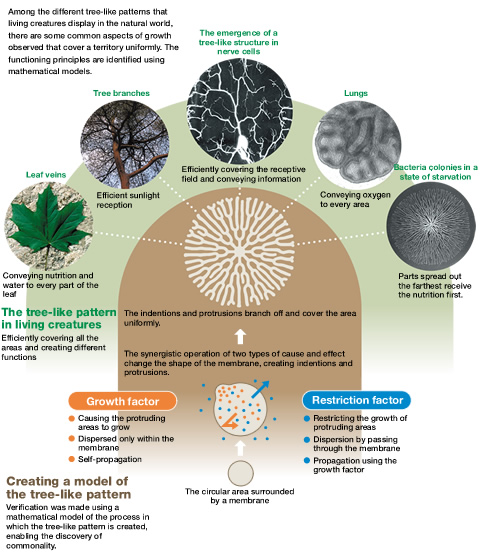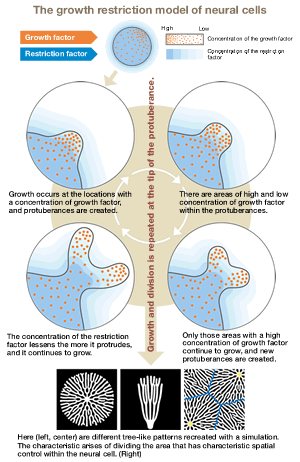Research
Discovering the principles by which form is created
The tree-like pattern exhibited by living creatures is created by the repeated growth and divergence of the ends of protuberances. We have established a model for controlling the growth of neural cells using the diffusion factor, and considered the principles of spatial control that function in the growth of these tree-like protuberances.
This model provides a small circular area that resembles a cell. It postulates a growth factor that causes the protuberance to grow, and a restriction factor that limits that function. The growth factor is dispersed only within that area, but the restriction factor passes through the membrane and is dispersed. It has the character of restricting protuberance growth on the perimeter.
We recreated a tree-like pattern with a computer simulation based on this model. We were able to understand the mechanism for the creation of the branching in the following way. Areas with a high concentration of the growth factor are sometimes created in cells, and these result in protuberances. The further the protuberances get from the membrane surface, the lower the concentration of the restriction factors becomes. The protuberance can continue to grow due to the diminution of the restrictive effect. Individual branches seem to behave in a localized manner, but in the end they create a tree-like pattern in which the branches are distributed somewhat uniformly.
The diffusion factor that restricts the growth of the protuberances will sometimes facilitate continued growth of the areas where the protuberances emerge, and they divide. We think this repetition of growth and division is the principle for the tree-like pattern observed in different living creatures.
Withdrew from the PhD program in science at Kyushu University in 1998, and became an assistant in the Faculty of Sciences at that Kyushu University. In 2002, he became an assistant professor at the Okazaki National Research Institutes (from 2004, the National Institutes of Natural Sciences). He was named an associate professor at the same institution in 2007.
Photographs:
Kaoru Sugimura (Kyoto University), Tadashi Uemura (Kyoto University)
(From Neuron 43, 809-822 (2004)) /
Takashi Miura (Kyoto University) / Mitsugu Matsushita (Chuo University)
*Titles omitted
- Dialogue:A space that living beings can inhabit is created
Toyo Ito / Keiko Nakamura - Research01:Discovering the principles by which form is created
Atsushi Mochizuki - Research02:A sensor that functions like the nose at the pole of the coliform bacillus
Ikuro Kawagishi - Scientist Library:From chromosome research to life inheritance science
Mitsuhiro Yanagida
|
|

